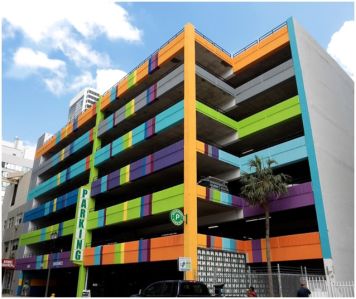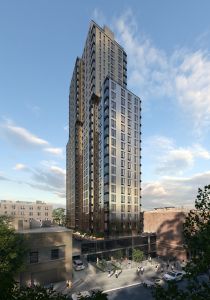Harbor Group International’s Richard Litton On Multifamily and the Best Debt Right Now
By Andrew Coen April 3, 2023 2:00 pm
reprints
When the COVID-19 pandemic brought the commercial real estate lending markets to a brief standstill in the spring of 2020, Harbor Group International (HGI) saw an opening to scale its business into senior lending.
The Norfolk, Va.-based owner and operator that summer launched a lending platform that provides senior mortgage bridge loans on multifamily properties throughout the U.S. HGI then completed a $245 million equity raise for the whole loan platform in January 2021, and then closed its first CRE collateralized loan obligation (CLO) that May.

On the sponsorship side of its business, HGI is better positioned than many other CRE owners given it’s weighted heavily toward the healthier multifamily sector and away from dicier office properties, which comprise only roughly 15.5 percent of its portfolio. The company was also very proactive in early 2022 as dislocation within the debt markets began to take hold. HGI sold off a number of its properties with floating-rate debt to raise its current percentage of fixed-rate assets to 71 percent, up from 60 percent early last year.
Richard Litton, president of HGI since 2005, spoke with Commercial Observer about how the choppy debt markets are impacting its CRE portfolio, the advantages of being a multifamily owner with executing its lending strategy, and the potential for more apartment acquisitions due to rising interest rate cap costs.
The interview has been edited for length and clarity.
Commercial Observer: Where were you raised and what were some of your interests growing up?
Richard Litton: I was born in Charleston, S.C., but from third grade on I was raised in southwestern Virginia, in a very, very small rural town called Buchanan. In terms of sports, I played baseball all the way through high school as that was my favorite sport. I have always been a big reader of American history, so any and all things American history has always been an interest for me — and, as a Virginian, there’s plenty of that.
Prior to arriving at HGI in 2004 you were a corporate attorney at one of Virginia’s largest law firms, Kaufman & Canoles. What prompted this transition into commercial real estate?
Several years before I joined Harbor Group, I was hired by Harbor Group Chairman and CEO Jordan Slone as Harbor Group’s outside corporate lawyer. So I had an opportunity to work closely with Harbor Group for several years in that capacity with Jordan and with other partners at Harbor Group. And a lot of that work I did related to partnerships and other corporate work as the firm was starting to attract larger and more institutional investors. So, really, from day one in that role I thought so much of the individuals and the plans for the company to grow and how it wanted to grow.
It became a fairly natural and not uncommon transition to go from an outside corporate lawyer at a firm to an in-house role. So I joined in May of 2004 as a general counsel, but also with a very specific goal of being more and more involved in the business as opposed to a purely legal role. I became president in May of 2005, and I’ve been in that role ever since.
How does your legal background benefit you in the president’s role?
For one, my work as an outside corporate lawyer was always very transaction-oriented, with mergers and acquisition work, securities and corporate work related to companies raising capital, buying and selling businesses. Everything Harbor Group does as a private equity firm has some components related to what I used to do as an outside legal counsel.
Like any private equity firm, we’re very transaction oriented and we raise outside capital, so a lot of those experiences and skill sets as an outside lawyer were fairly easily transferable into what we do in our group. You learn a lot about structuring and tax and negotiating strategies and negotiating styles and all the other things that are involved in getting a transaction to the finish line.
In 2020 during the height of the pandemic you launched a lending platform that provides senior mortgage bridge loans on multifamily properties throughout the U.S. What spurred this?
The first step was to start doing multifamily credit investments of some different types. In 2007, we started doing preferred equity and mezzanine loans. In 2015, we started acquiring Freddie Mac (FMCC) B pieces. So, by 2020, we already had a quite robust multifamily credit business and different strategies, but we had not originated our own senior mortgages. We had talked about it for years, but it was a crowded space, a crowded field, and the question was when would be the right time to launch that business.
With COVID, we went through a period of time — a relatively short period of time, but a period of time nonetheless — where there really was a lack of liquidity in the market. We felt like that was the time we could enter the sector and achieve some outsized returns. We were very fortunate to raise some meaningful capital around the strategy during the depths of COVID and then launch the business in late summer of 2020 and start closing loans by August. It was a natural progression of our multifamily credit line of business, but it was a matter of finding the right time in the cycle to actually enter the market as a senior lender.
How has being a longtime multifamily owner and operator aided your lending business?
It’s been very powerful for us to also be an owner in a couple of different ways. One is with our multifamily investment professionals; we don’t break them down between debt officers. We have multifamily specialists and they cover different geographic regions, so the same transaction officer that might source an apartment property to buy in Phoenix is going to be the same person who’s covering that market to make senior loans or preferred equity fundings or mezzanine loans. By having professionals dedicated to regions, you really are able to develop very deep relationships that get you lots of different types of opportunities, so I think it’s been very impactful from a deal flow perspective.
Also, we have so much in-house data from our owned real estate. If we are looking at a whole loan in Atlanta and the properties in a particular submarket and there’s a particular business plan to renovate the property and achieve certain rent growth, we have tremendous in-house data already based on real estate we own, or it could be loans within our Freddie Mac B-piece pools. We have real-time information on what’s going on in a particular market, and I think it helps us really do a good job of assessing the business plans of sponsors that we’re considering lending to.
What has lending volume been like in the last year since the dislocation of the debt markets began to take hold amid rising interest rates?
In the last year it has been steadily declining. We were still certainly active this time a year ago, which would have been weeks after Russia’s invasion of Ukraine. We were starting to see some choppiness but there was still transaction activity so we were fairly active. But it’s been a steadily declining opportunity set for our whole loan business, and we’ve frankly done very, very little of it in the first quarter of this year. That’s a product of dramatically reduced transaction volume. That business obviously depends on sales to occur and refinancings to occur.
Also, our product is only floating-rate and given the [Secured Overnight Financing Rate] index combined with the spread we need to charge on our loans, it’s frankly very expensive debt. Borrowers are far more interested in the current cycle acquiring fixed-rate financing as opposed to floating-rate.
In May 2021, you launched HGI’s first CLO composed of bridge loans on multifamily assets across the U.S. How has demand for this platform held up with the market fluctuations in the last two years?
That’s an execution strategy for the same sort of loan business. That initial CLO was a pool of loans that we originated once we started the business. And, you know, at that time throughout 2021 and into 2022, the CLO market was robust and active. We’ve done a total of three CLOs. We’ve done a Freddie Mac Q transaction, which is another form of a CLO execution facilitated by Freddie Mac. But, really, that market, which depends on bond buyers, has been very shallow in recent periods. Since that Freddie Q transaction it has not made sense to access the securitization markets, and we’ve just kept the few loans that we do have on our balance sheet.
Turning to the sponsorship side of your business, you were proactive in early 2022 anticipating a rising interest rate environment by selling off a number of properties with floating-rate debt. How has this move affected your portfolio’s performance?
We saw the market starting to move, particularly with interest rates, towards the end of the first quarter of 2022. We decided to sell a lot of multifamily while the pricing environment was still strong, and we focused in particular on selling assets that were financed with floating-rate debt. We made a very conscious effort to end that period of dispositions with a bigger percentage of our portfolio subjected to fixed-rate debt and we were very successful doing that. By the time we had completed our target dispositions in late summer of 2022, over 70 percent of our owned portfolio was financed with fixed-rate debt.
And, ever since then and including the first quarter of this year, where we’ve had opportunities to sell at pricing that made sense or had opportunities to refinance out of floating-rate debt into fixed-rate debt, we’ve really worked hard to take advantage of that. So we continue to orient with every opportunity we can to take floating-rate debt off the books on our own portfolio and either sell or be in a fixed-rate financing structure.
What geographic markets are you most focused on now?
We certainly have been focused and continue to focus on the Sun Belt growth markets. We’ve made very significant investments in Florida over the last year, including in particular South Florida, given the strong in-migration trends and job-driver trends. We certainly still very much like the large Texas markets. We had been through a period of time where we did not buy in Phoenix because we thought pricing had gotten overly robust, but once pricing got better, as a buyer, we acquired again in Phoenix several assets in the last part of 2022.
So, mid-Atlantic, Southeast, Southwest have been principally where we focused, but we are very sort of granular in terms of looking at opportunities, and there are other markets where we’ve acquired and done very well. Columbus, Ohio, for example, has been a terrific market for us and has a lot of good dynamics as an apartment market for investors.
What types of buying opportunities do you see resulting this year from the rising costs of interest rate caps?
We do expect that owners with floating-rate debt, and in particular floating-rate debt that’s going to require a replacement of interest rate caps, to see some real pressure, particularly in the second half of the year. The cost of debt servicing has obviously increased dramatically for any owner with floating-rate debt, and then the cost to replace the interest rate caps that are expiring is for many owners prohibitively expensive.
If you think about all the robust transaction activity in the fall of 2020 and fall 2021, if you were buying a three-year cap in the fall of 2020 or a two-year cap in the fall of ’21, those are all expiring this fall, and we think that that will be a real trigger for increased transaction activity. We think it’s something that lenders are closely watching as well as borrowers themselves, and we just think it’s going to be a catalyst for much more robust capital markets activity in the last part of the year.
Obviously it’s very fluid, but how do you expect the banking crisis after the failures of Silicon Valley Bank (SIVBQ) and Signature Bank (SBNY) to affect HGI’s business?
Obviously, some of the regional banks — not necessarily Silicon Valley Bank, but certainly Signature Bank and some other regional banks that have been under pressure — have been active lenders in commercial real estate. So, to the extent that that capital is not available, that could certainly have an impact on available debt liquidity.
We were already in a situation where the very large money-center banks were being very cautious on new lending, so there are some stresses in the market in terms of available debt capital. Multifamily has the very important benefit obviously of Freddie Mac and Fannie Mae (FNMA) as they remain very active. They’re active for us in terms of anything we’re looking to refinance into fixed-rate debt. We’ve got a good pipeline with Freddie Mac in particular to refinance into fixed-rate debt and, then, to the extent they have increasing volumes, that certainly benefits us as a B-piece buyer as well.
The office sector is another class that represents roughly 15.5 percent of our assets under management. That’s a different situation. Obviously, that sector does not benefit from Freddie Mac and Fannie Mae, and there is a real absolute lack of any meaningful debt in the office sector. So that’s a real stress point for the office sector.
It certainly benefits you to be more weighted toward multifamily, which experienced healthy growth during the first two years of the pandemic. It has shown some signs of cooling down of late from a very hot period. How do you see the sector shaping up for the rest of this year and beyond?
Certainly, the very, very significant rent increases in some markets, pushing up 20 to 25 and even 30 percent, that wasn’t sustainable, nor did we ever invest or underwrite or project that would continue, so it’s not surprising that rent growth has leveled off.
That said, we’re still seeing rent growth in our portfolio on renewals and on new leases or trade-out rents at a much more moderate level but healthy nonetheless. We still have the backdrop of an insufficient housing supply in the United States, and, particularly with construction costs and then an inflationary environment, that only puts more pressure on supply. So overall supply and demand metrics still feel very good as an apartment investor, and we expect that to continue in the United States for the foreseeable future.


